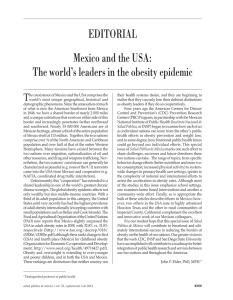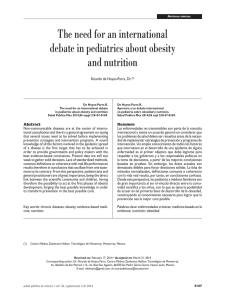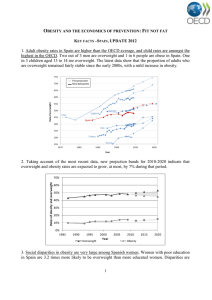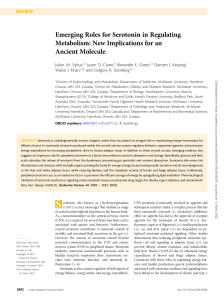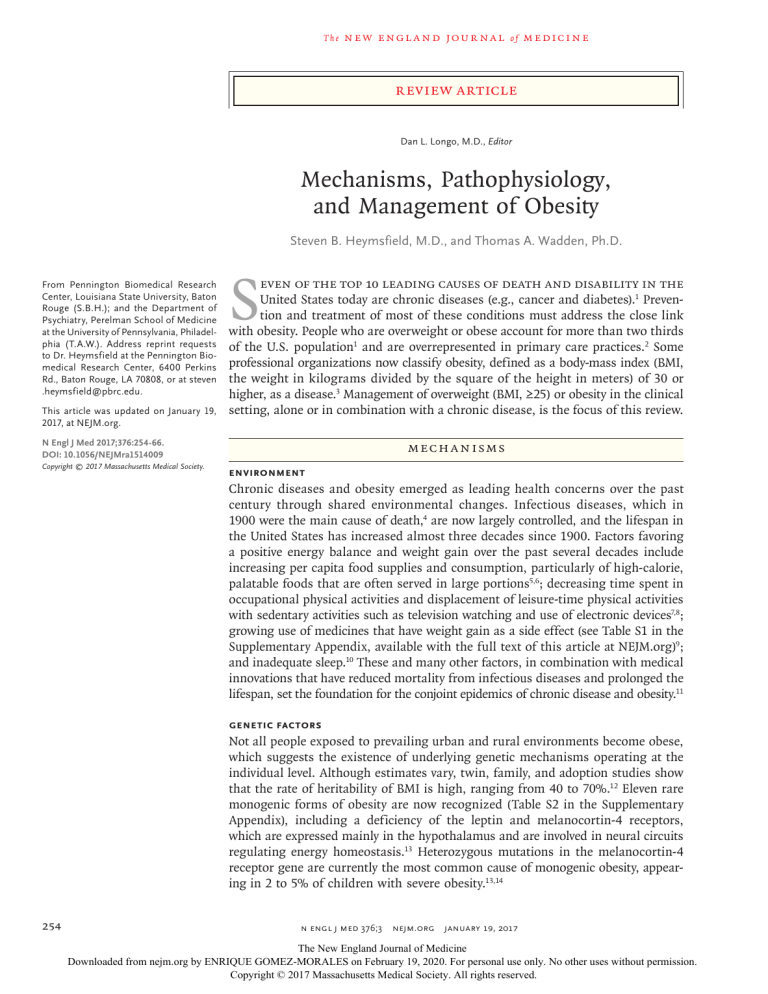
The n e w e ng l a n d j o u r na l of m e dic i n e Review Article Dan L. Longo, M.D., Editor Mechanisms, Pathophysiology, and Management of Obesity Steven B. Heymsfield, M.D., and Thomas A. Wadden, Ph.D. From Pennington Biomedical Research Center, Louisiana State University, Baton Rouge (S.B.H.); and the Department of Psychiatry, Perelman School of Medicine at the University of Pennsylvania, Philadelphia (T.A.W.). Address reprint requests to Dr. Heymsfield at the Pennington Biomedical Research Center, 6400 Perkins Rd., Baton Rouge, LA 70808, or at ­steven .­heymsfield@­pbrc.­edu. This article was updated on January 19, 2017, at NEJM.org. S even of the top 10 leading causes of death and disability in the United States today are chronic diseases (e.g., cancer and diabetes).1 Prevention and treatment of most of these conditions must address the close link with obesity. People who are overweight or obese account for more than two thirds of the U.S. population1 and are overrepresented in primary care practices.2 Some professional organizations now classify obesity, defined as a body-mass index (BMI, the weight in kilograms divided by the square of the height in meters) of 30 or higher, as a disease.3 Management of overweight (BMI, ≥25) or obesity in the clinical setting, alone or in combination with a chronic disease, is the focus of this review. N Engl J Med 2017;376:254-66. DOI: 10.1056/NEJMra1514009 Copyright © 2017 Massachusetts Medical Society. Mech a nisms Environment Chronic diseases and obesity emerged as leading health concerns over the past century through shared environmental changes. Infectious diseases, which in 1900 were the main cause of death,4 are now largely controlled, and the lifespan in the United States has increased almost three decades since 1900. Factors favoring a positive energy balance and weight gain over the past several decades include increasing per capita food supplies and consumption, particularly of high-calorie, palatable foods that are often served in large portions5,6; decreasing time spent in occupational physical activities and displacement of leisure-time physical activities with sedentary activities such as television watching and use of electronic devices7,8; growing use of medicines that have weight gain as a side effect (see Table S1 in the Supplementary Appendix, available with the full text of this article at NEJM.org)9; and inadequate sleep.10 These and many other factors, in combination with medical innovations that have reduced mortality from infectious diseases and prolonged the lifespan, set the foundation for the conjoint epidemics of chronic disease and obesity.11 Genetic Factors Not all people exposed to prevailing urban and rural environments become obese, which suggests the existence of underlying genetic mechanisms operating at the individual level. Although estimates vary, twin, family, and adoption studies show that the rate of heritability of BMI is high, ranging from 40 to 70%.12 Eleven rare monogenic forms of obesity are now recognized (Table S2 in the Supplementary Appendix), including a deficiency of the leptin and melanocortin-4 receptors, which are expressed mainly in the hypothalamus and are involved in neural circuits regulating energy homeostasis.13 Heterozygous mutations in the melanocortin-4 receptor gene are currently the most common cause of monogenic obesity, appearing in 2 to 5% of children with severe obesity.13,14 254 n engl j med 376;3 nejm.org January 19, 2017 The New England Journal of Medicine Downloaded from nejm.org by ENRIQUE GOMEZ-MORALES on February 19, 2020. For personal use only. No other uses without permission. Copyright © 2017 Massachusetts Medical Society. All rights reserved. Obesity A widely used strategy to discover polygenic mechanisms conferring susceptibility to common obesity involves screening the entire genome in large samples with the goal of identifying singlenucleotide polymorphisms associated with BMI and other traits linked with obesity.13 Over 300 loci have been identified in genomewide association studies, although collectively these loci account for less than 5% of individual variation in BMI and adiposity traits.13 The most prominent signals using this approach are the FTO gene variants; persons carrying one or two copies of the risk allele have a 1.2-kg or 3-kg increase in weight, respectively, as compared with persons without copies of the allele.13 Whole-exome and whole-genome sequencing offers the possibility of identifying new molecular targets and improved risk-prediction markers. Changes in gene transcription and translation through environmental influences can occur without modifications in the DNA nucleotide sequence. Epigenome-wide association studies are elucidating prenatal and postnatal exposures that may influence metabolic health outcomes.15 Epigenetic effects may thus account for additional between-individual differences in BMI and phenotypic obesity traits.12 Energy-Balance Dysregulation Genes and environment interact in a complex system that regulates energy balance, linked physiological processes, and weight.13,14 Two sets of neurons in the hypothalamic arcuate nucleus that are inhibited or excited by circulating neuropeptide hormones control energy balance by regulating food intake and energy expenditure. Short-term and long-term energy balance is controlled through a coordinated network of central mechanisms and peripheral signals that arise from the microbiome and cells within adipose tissue, stomach, pancreas, and other organs.14 Brain regions outside the hypothalamus contribute to energy-balance regulation through sensorysignal input, cognitive processes, the hedonic effects of food consumption, memory, and attention.14 Reducing food intake or increasing physical activity leads to a negative energy balance and a cascade of central and peripheral compensatory adaptive mechanisms that preserve vital functions.16 Viewed clinically, these effects may be associated with relative reductions in resting n engl j med 376;3 energy expenditure, food preoccupation, and many other metabolic and psychological processes that depend on the magnitude and duration of caloric restriction.17,18 An increase in central orexigenic signals may account for a subtle and often unappreciated counterregulatory increase in appetite and food intake that limits the degree of predicted weight loss that is associated with interventions such as exercise programs.19 These well-established metabolic and physiological effects that appear during weight loss may be maintained in the weight-reduced state.16,17 Although the magnitude and underlying mechanisms of these effects in humans remain unclear, the implication is that persons who are no longer obese may not be physiologically and metabolically identical to their counterparts who were never obese.16,17 High relapse rates are in accord with this view and are consistent with the concept of obesity as a chronic disease that requires long-term vigilance and weight management. Pathoph ysiol o gic a l Fe at ur e s Anatomical Effects Excess adiposity typically evolves slowly over time, with a long-term positive energy balance. Accretion of lipids, mainly triglycerides, in the adipose tissue occurs in conjunction with volume increases in skeletal muscle, liver, and other organs and tissues; the excess weight in persons who are overweight or obese includes variable proportions of these organs and tissues.20 An obese person with stable weight, as compared with a person without overweight or obesity, thus has larger fat and lean mass, along with higher resting energy expenditure, cardiac output, and blood pressure and greater pancreatic β-cell mass.20,21 Insulin secretion in the fasting state and after a glucose load increases linearly with the BMI.22 With weight gain over time, excess lipids are distributed to many body compartments. Subcutaneous adipose tissue holds most of the stored lipid at a variety of anatomical sites that differ in metabolic and physiological characteristics.23 Most of the adipocytes in subcutaneous adipose tissue are white (see the Glossary for definitions of the types of fat cells), owing to stored triglycerides; relatively small and variable amounts of thermogenic brown and beige adipocytes are also present in adults.24 Obesity is accompanied nejm.org January 19, 2017 The New England Journal of Medicine Downloaded from nejm.org by ENRIQUE GOMEZ-MORALES on February 19, 2020. For personal use only. No other uses without permission. Copyright © 2017 Massachusetts Medical Society. All rights reserved. 255 The n e w e ng l a n d j o u r na l of m e dic i n e Glossary White adipocytes: White adipocytes are the main cell type found in human adipose tissue. Energy-yielding triglycerides and cholesterol ester are stored within the large intracellular lipid droplets. Leptin, adiponectin, and other adipokines are among the proteins secreted by white adipocytes. Brown adipocytes: With the use of imaging methods, deposits of brown adipocytes are observed within supraclavicular, paravertebral, mediastinal, and other adipose-tissue depots in adults. Multiple lipid droplets and uncoupling protein 1– containing mitochondria are found within brown adipocytes, which can be activated to produce heat through sympathetic nervous system stimulation after cold exposure. Beige adipocytes: Thermogenic beige or “brite” (brown-and-white) adipocytes are found scattered within white adipose tissue. They are characterized by multiple lipid droplets and uncoupling protein 1–containing mitochondria and have a progenitor cellular origin. “Browning” of white adipose tissue can be induced with cold exposure, exercise, and some endocrine hormones. by increases in macrophages and other immune cells in adipose tissue, in part because of tissue remodeling in response to adipocyte apoptosis.25 These immune cells secrete proinflammatory cytokines, which contribute to the insulin resistance that is often present in patients with obesity. Visceral adipose tissue is a smaller storage compartment for lipids than is subcutaneous adipose tissue, with omental and mesenteric fat mechanistically linked to many of the metabolic disturbances and adverse outcomes associated with obesity.23,24 Adipose tissue surrounds the kidney, and the blood-pressure increase with renal compression may contribute to the hypertension frequently observed in patients who are obese.21 Obesity is often accompanied by an increase in pharyngeal soft tissues, which can block airways during sleep and lead to obstructive sleep apnea.26 Excess adiposity also imposes a mechanical load on joints, making obesity a risk factor for the development of osteoarthritis.27 An increase in intraabdominal pressure purportedly accounts for the elevated risks of gastroesophageal reflux disease, Barrett’s esophagus, and esophageal adenocarcinoma among persons who are overweight or obese.28 Metabolic and Physiological Effects Adipocytes synthesize adipokines (cell-signaling proteins) and hormones, the secretion rates and effects of which are influenced by the distribution and amount of adipose tissue present.24 Excessive secretion of proinflammatory adipokines by adipocytes and macrophages within adipose tissue leads to a low-grade systemic inflammatory state in some persons with obesity.24 Hydrolysis of triglycerides within adipocytes releases free fatty acids, which are then transported in plasma to sites where they can be use256 n engl j med 376;3 ful metabolically. Plasma free fatty acid levels are often high in patients with obesity, reflecting several sources that include the enlarged adipose tissue mass.24 In addition to being found in adipose tissue, lipids are also found in liposomes, which are small cytoplasmic organelles in proximity to the mitochondria in many types of cells.29 With excess adiposity, liposomes in hepatocytes can increase in size (steatosis), forming large vacuoles that are accompanied by a series of pathological states, including nonalcoholic fatty liver disease, steatohepatitis, and cirrhosis.30 Accumulation of excess lipid intermediates (e.g., ceramides) in some nonadipose tissues can lead to lipotoxicity with cellular dysfunction and apoptosis.24 Elevated levels of free fatty acids, inflammatory cytokines, and lipid intermediates in nonadipose tissues contribute to impaired insulin signaling and the insulin-resistant state that is present in many patients who are overweight or obese.24,31 Insulin resistance is also strongly linked with excess intraabdominal adipose tissue.24,31 This constellation of metabolic and anatomical findings is one of several pathophysiological mechanisms underlying the dyslipidemia of obesity (elevated fasting plasma triglyceride and low-density lipoprotein cholesterol levels and low levels of high-density lipoprotein cholesterol), type 2 diabetes, obesity-related liver disease, and osteoarthritis. Elevated bioavailable levels of insulin-like growth factor 1 and other tumorpromoting molecules have been implicated in the development of some cancers.32 Chronic overactivity of the sympathetic nervous system is present in some patients with obesity and may account in part for multiple pathophysiological processes, including high blood pressure.21 Heart diseases, stroke, and nejm.org January 19, 2017 The New England Journal of Medicine Downloaded from nejm.org by ENRIQUE GOMEZ-MORALES on February 19, 2020. For personal use only. No other uses without permission. Copyright © 2017 Massachusetts Medical Society. All rights reserved. Obesity ↑ Adiposity ↑ Adipokine synthesis ↑ Lipid production ↑ Adipose tissue macrophages and other inflammatory cells Hydrolysis of triglycerides ↑ Proinflammatory cytokines Release of free fatty acids ↑ Activity of the sympathetic nervous system ↑ Activity of the renin–angiotensin– aldosterone system Renal compression Impaired insulin signaling and ↑ insulin resistance Lipotoxicity Mechanical stress ↑ Pharyngeal soft tissue ↑ Mechanical load on joints ↑ Intraabdominal pressure Obstructive sleep apnea Osteoarthritis Gastroesophageal reflux disease Dyslipidemia Systemic and pulmonary hypertension ↑ Insulin Nonalcoholic fatty liver disease Type 2 diabetes Steatohepatitis Cirrhosis Coronary artery disease Barrett’s esophagus Esophageal adenocarcinoma Congestive heart failure Stroke Chronic kidney disease Figure 1. Some Pathways through Which Excess Adiposity Leads to Major Risk Factors and Common Chronic Diseases. Common chronic diseases are shown in red boxes. The dashed arrow denotes an indirect association. chronic kidney diseases all have as their main pathophysiological mechanisms high blood pressure and the cluster of findings associated with insulin resistance, obesity-associated dyslipidn engl j med 376;3 emia, and type 2 diabetes. Figure 1 shows some of the pathways by which the mechanical, metabolic, and physiological effects of excess adiposity lead to coexisting chronic diseases. nejm.org January 19, 2017 The New England Journal of Medicine Downloaded from nejm.org by ENRIQUE GOMEZ-MORALES on February 19, 2020. For personal use only. No other uses without permission. Copyright © 2017 Massachusetts Medical Society. All rights reserved. 257 The n e w e ng l a n d j o u r na l Psychological Effects Obesity is associated with an increased prevalence of mood, anxiety, and other psychiatric disorders, particularly among persons with severe obesity and those seeking bariatric surgery.33,34 Causal pathways between obesity and psychiatric disorders may be bidirectional.35 Moreover, medications used to treat bipolar disorder, major depression, and some psychotic disorders can be accompanied by substantial weight gain (Table S1 in the Supplementary Appendix).9,33 R e sp onse t o W eigh t L oss When a negative energy balance is induced by reducing food intake, increasing activity levels, or both, thermodynamic prediction models accurately define the weight-loss trajectory in adherent patients.36 Most patients reach a weightloss nadir earlier than predicted by these models, after only several months, and gradually gain weight thereafter. The regained weight is related to decreased adherence to diet and activity prescriptions and to increasingly recognized endogenous compensatory mechanisms.16,37 Moderate weight loss, defined as a 5 to 10% reduction in baseline weight, is associated with clinically meaningful improvements in obesityrelated metabolic risk factors and coexisting disorders.9,38,39 A 5% weight loss improves pancreatic β-cell function and the sensitivity of liver and skeletal muscle to insulin; a larger relative weight loss leads to graded improvements in key adipose-tissue disturbances.40 These salutary effects were observed clinically in overweight and obese patients with type 2 diabetes who were treated with an intensive lifestyle intervention in the Look AHEAD (Action for Health in Diabetes) study.41 At 1 year, patients had a mean weight loss of 8.6% of baseline weight, which was accompanied by significant reductions in systolic and diastolic blood pressure (of 6.8 and 3.0 mm Hg, respectively) and levels of triglycerides (of 30.3 mg per deciliter [0.34 mmol per liter]) and glycosylated hemoglobin (of 0.64%). A graded response was observed for these weight-sensitive measures, with larger weight losses accompanied by greater improvements.42 Moderate weight loss can translate to disease prevention in high-risk persons. Patients with overweight or obesity and impaired glucose tol- 258 n engl j med 376;3 of m e dic i n e erance who received an intensive lifestyle intervention in the Diabetes Prevention Program had a mean weight loss of 5.6 kg at 2.8 years and a 58% relative reduction in the risk of type 2 diabetes.43 The incidence of type 2 diabetes remained 34% below the incidence in the control group at 10 years of follow-up, even though the participants in the intervention group had, on average, returned to close to their baseline weight.44 Mean losses of 16 to 32% of baseline weight produced by bariatric surgery in patients with severe obesity may lead to disease remission, including remission of type 2 diabetes in patients who undergo bariatric surgery, particularly Rouxen-Y gastric bypass.45-50 Significant reductions in all-cause mortality have also been shown in observational studies of surgically treated patients.51,52 Although weight loss is an effective, broadacting therapeutic measure, not all risk factors and chronic disease states respond equally well.38,39,42 Severe obstructive sleep apnea, for example, improves but rarely fully remits in response to weight-loss treatments, including bariatric surgery.26 Moreover, the beneficial clinical effects of moderate weight loss achieved with intensive lifestyle intervention did not reduce morbidity and mortality associated with cardiovascular disease after 9.6 years in the Look AHEAD study.53 Well-established medical therapies must be used with weight loss to achieve good control of obesity-related coexisting conditions. Similarly, symptoms of some psychiatric disorders may improve with weight loss,33,54 but adjunctive psychiatric care is critical, particularly in persons with moderate or severe disorders. For example, adjunctive care has been shown to be of value for improving mental health and eating behaviors such as binge eating.34 Cl inic a l C a r e Assessment The obese phenotype is complex, and some patients do not have any evident cardiometabolic effects, a phenomenon that has been called the “metabolically healthy” obese state.55 Clusters of findings related to insulin resistance with an enlarged intraabdominal and upper-body subcutaneous adipose-tissue mass are consistent with the diagnosis of a metabolic syndrome.24,31 Although the BMI is a good proxy for adipos- nejm.org January 19, 2017 The New England Journal of Medicine Downloaded from nejm.org by ENRIQUE GOMEZ-MORALES on February 19, 2020. For personal use only. No other uses without permission. Copyright © 2017 Massachusetts Medical Society. All rights reserved. Obesity Table 1. Recommended Components of a High-Intensity Comprehensive Lifestyle Intervention to Achieve and Maintain a 5-to-10% Reduction in Body Weight.* Component Weight Loss Weight-Loss Maintenance Counseling ≥14 in-person counseling sessions (individual or group) with a trained interventionist during a 6-mo period; recommendations for similarly structured, comprehensive Web-based interventions, as well as evidencebased commercial programs Monthly or more frequent in-person or telephone sessions for ≥1 yr with a trained interventionist Diet Low-calorie diet (typically 1200–1500 kcal per day for women and 1500–1800 kcal per day for men), with macronutrient composition based on patient’s preferences and health status Reduced-calorie diet, consistent with reduced body weight, with macronutrient composition based on patient’s ­preferences and health status Physical activity ≥150 min per week of aerobic activity (e.g., brisk walking) 200–300 min per week of aerobic activity (e.g., brisk walking) Behavioral therapy Daily monitoring of food intake and physical activity, facili- Occasional or frequent monitoring of food intake and phy­ tated by paper diaries or smart-phone applications; sical activity, as needed; weekly-to-daily monitoring of weekly monitoring of weight; structured curriculum of weight; curriculum of behavioral change, including probbehavioral change (e.g., DPP), including goal setting, lem solving, cognitive restructuring, and relapse prevenproblem solving, and stimulus control; regular feedtion; regular feedback from a trained interventionist back and support from a trained interventionist *Data are from the Guidelines (2013) for the Management of Overweight and Obesity in Adults, reported by Jensen et al.39 The guidelines concluded that a variety of dietary approaches that differ widely in macronutrient composition, including ad libitum approaches (in which a lower calorie intake is achieved by restriction or elimination of particular food groups or by the provision of prescribed foods), can lead to weight loss provided they induce an adequate energy deficit. The guidelines recommended that practitioners, in selecting a weight-loss diet, consider its potential contribution to the management of obesity-related coexisting disorders (e.g., type 2 diabetes and hypertension). The guidelines did not address the possible benefits of strength training, in addition to aerobic activity. DPP denotes Diabetes Prevention Program. ity at the group level, each patient’s risk can be stratified further on the basis of a personal and family medical history, a psychiatric history,33 and blood studies, as well as a behavioral history that includes information about physical activity, nutrition, and eating behavior.34 Waist circumference is also a useful measure of intraabdominal and upper-body subcutaneous adipose tissue, and some guidelines include it as a risk marker in addition to or in place of the BMI.31,39 Treatment Treatments should be aligned with the severity of overweight, associated coexisting chronic diseases, and functional limitations. Useful guidelines are available for evaluating an individual patient’s health risks and treatment options.38,39,56 The main treatment options with sufficient evidence-based support are lifestyle intervention, pharmacotherapy, and bariatric surgery.9,38,39,57 Lifestyle Intervention Lifestyle interventions designed to modify eating behaviors and physical activity are the first option for weight management, given their low cost and the minimal risk of complications.39 n engl j med 376;3 The aim for patients who are overweight or obese is to improve health and quality of life by achieving and maintaining moderate weight loss. Extensive research led to current recommendations that patients receive high-intensity behavioral counseling, with 14 or more visits in 6 months39 (Table 1). A comprehensive program, delivered by a trained interventionist, results in a mean weight loss of 5 to 8%,39 and approximately 60 to 65% of patients lose 5% or more of initial weight (Fig. 2). Less-intensive lifestyle counseling is an option for preventing additional weight gain in patients who are at low risk for disease or who choose not to participate in a high-intensity program. Behavioral therapy, the core of lifestyle intervention, provides patients with techniques for adopting dietary and activity recommendations.39 Foremost among these recommendations is regular recording of food intake, physical activity, and weight. This task can be facilitated by smartphone applications, activity counters, and cellularconnected scales.39,63 Patients review their progress approximately weekly with a trained interventionist who provides encouragement and goalsetting and problem-solving instructions.39 nejm.org January 19, 2017 The New England Journal of Medicine Downloaded from nejm.org by ENRIQUE GOMEZ-MORALES on February 19, 2020. For personal use only. No other uses without permission. Copyright © 2017 Massachusetts Medical Society. All rights reserved. 259 The n e w e ng l a n d j o u r na l of m e dic i n e ≥10% High-Intensity Lifestyle Intervention ≥5% Look AHEAD DPP Teixeira, et al. Placebo Orlistat Pharmacotherapy Intervention Lorcaserin Liraglutide Phentermine–topiramate Naltrexone–bupropion 0 10 20 30 40 50 60 70 80 90 100 Percentage of Participants Figure 2. Weight Loss at 1 Year with High-Intensity Lifestyle Interventions or Pharmacotherapy Combined with Lowto-Moderate-Intensity Lifestyle Counseling. Shown are the percentages of participants in randomized, controlled trials who had weight loss of at least 5% or at least 10% of their initial weight at 1 year after a high-intensity lifestyle intervention or pharmacotherapy that typically was combined with low-to-moderate-intensity lifestyle counseling (≤1 session per month). Percentages shown are cumulative; the percentage of participants who lost at least 5% of their initial weight includes the percentage who lost at least 10%. For example, 68% of participants in the Look AHEAD study lost at least 5% of their initial weight, and 37% of these participants lost at least 10%. The lifestyle intervention trials (Look AHEAD,41 the Diabetes Prevention Program [DPP] trial,43 and the trial reported by Teixeira et al.58) were selected because they were judged to be of fair or good quality by the Guidelines (2013) for the Management of Overweight and Obesity in Adults39 and because the trial data are reported as categorical weight losses. Additional categorical weight-loss data from the DPP trial43 were provided by the DPP Research Group. The median percentages of participants who had a weight loss of at least 5% or 10% with each of five medications approved for long-term weight management are from a metaanalysis by Khera et al.59 Data on the percentage of participants with weight loss at 1 year of at least 15% of their ­initial weight were available for the Look AHEAD study41,42 (16%), the DPP trial43 (11%), liraglutide60 (14%), phentermine–topiramate61 (32%), and naltrexone–bupropion62 (14%). Primary care practitioners frequently provide recommendations for dietary and activity modification but are usually unable to offer highintensity behavioral counseling.64 Moreover, despite their role at the front line of obesity management, physicians receive minimal training in nutrition and activity counseling.65 Recommendations alone, including encouragement to use a smart-phone application, result in minimal weight loss, which can frustrate both practi­t ioners and patients. Referring patients to high-intensity community interventions is an important option. YMCAs increasingly offer a version of the Diabetes Prevention Program,66 and commercial weightloss programs can be prescribed if their safety and efficacy have been reported in peer-reviewed 260 n engl j med 376;3 publications (e.g., Weight Watchers and Jenny Craig).39 Telephone-delivered lifestyle interventions result in approximately the same weight loss as in-person counseling, thus encouraging the development of weight-management call centers.67 Web-based interventions that include personalized interventionist feedback can be prescribed but typically result in only one half to two thirds of the weight loss achieved with in-person counseling.39,68 Web-based interventions, however, potentially have greater reach and convenience and lower costs than in-person counseling. Weight regain is common after a patient completes a lifestyle intervention program.39 The most effective behavioral method for preventing weight regain is continued support on an every-other- nejm.org January 19, 2017 The New England Journal of Medicine Downloaded from nejm.org by ENRIQUE GOMEZ-MORALES on February 19, 2020. For personal use only. No other uses without permission. Copyright © 2017 Massachusetts Medical Society. All rights reserved. Obesity week or monthly basis, whether in person or by telephone.39,69 Although long-term behavioral counseling is effective, it is not widely available. Moreover, when this approach fails to produce the additional weight loss that patients desire, it is challenging to persuade the patients to remain in counseling to maintain the smaller weight loss they have achieved.39 Pharmacotherapy Pharmacotherapy is indicated as an adjunct to a reduced-calorie diet and increased activity for long-term weight management.9,38,70 Medications may be considered in adults who have a BMI of 30 or higher or a BMI of 27 to 29 with at least one weight-related coexisting condition.9 Pharmacotherapy and lifestyle intervention lead to additive weight loss and should be used together. Pharmacotherapy with lifestyle intervention may also be of benefit in facilitating the maintenance of reduced weight.9,38,70 Phentermine, the most widely prescribed weight-management medication in the United States, is a low-cost sympathomimetic amine that was approved by the Food and Drug Administration (FDA) in 1959 for short-term use (≤3 months).9 The availability of five newer FDAapproved medications for weight management, along with complexities surrounding the prescribing of phentermine, has led some professional groups to discourage long-term use of phentermine.9,38,70 For approval of a new weight-loss drug, the FDA requires trials of at least 1 year’s duration that show the safety of the drug and a mean difference of 5% or more in weight loss between the medication group and the placebo group. Alternatively, the proportion of drug-group participants who lose 5% or more of baseline weight must be at least 35% and approximately double the proportion in the placebo group.70 The five medications approved for long-term weight management include three single drugs and two combination drugs. The main features of these drugs, which are typically combined with low-to-moderate-intensity lifestyle counseling (≤1 session per month), are summarized in Table 2. In 1-year pivotal trials, total weight losses for the three monotherapies (orlistat, lorcaserin, and liraglutide), whose effects are mediated by different mechanisms, ranged from 5.8 to 8.8 kg (5.8 n engl j med 376;3 to 8.8% of initial body weight).9,60,71,72 Placebosubtracted weight losses, determined from a metaanalysis, ranged from 2.6 to 5.3 kg.59 The two combination medications (phentermine–topiramate and naltrexone–bupropion) include drugs that purportedly act additively or synergistically on neural weight-loss mechanisms.61,62 In 1-year pivotal trials, total weight loss for these combination drugs ranged from 6.2 to 10.2 kg (6.4 to 9.8% of initial body weight); placebosubtracted weight loss was 8.8 kg for phentermine–topiramate and 5.0 kg for naltrexone– bupropion.59,61,62 Categorical 1-year weight losses for the five FDA-approved drugs are shown in Figure 2. Weight loss achieved with pharmacotherapy is generally associated with improvements in risk factors and chronic diseases, as shown for glycosylated hemoglobin in patients with type 2 diabetes (Fig. S1 in the Supplementary Appendix). However, some drugs may increase the pulse rate60 or attenuate expected blood-pressure reductions.62 In addition, FDA-mandated postmarketing trials of cardiovascular disease outcomes in patients treated with these medications have yet to be completed, except in the case of liraglutide.60 Terminating medication after 12 to 16 weeks in patients who do not lose at least 5% of weight increases the likelihood of a clinically meaningful benefit in those who continue to receive treatment.38,70 The benefit also may be increased by aligning the prescribed weight-loss medication with treatment of coexisting medical or psychiatric conditions.9,38 For a number of reasons, physicians do not use weight-loss medications to the extent that one might expect, given the scale of the obesity problem.70 First, patients are often disappointed by moderate weight loss. Dissatisfaction with the results, coupled with requirements to pay a substantial portion of costs, may lead to short-term rather than long-term use. Also, some practitioners appear to have lingering concerns about medication safety and may be awaiting the outcome of FDA-mandated cardiovascular disease trials. Final­ ly, weight regain is common after termination of drug treatment70 and is discouraging to patients and practitioners. Long-term use of weight-loss medications, as approved by the FDA, may be necessary for long-term weight management, just as medications for hypertension, dyslipidemia, nejm.org January 19, 2017 The New England Journal of Medicine Downloaded from nejm.org by ENRIQUE GOMEZ-MORALES on February 19, 2020. For personal use only. No other uses without permission. Copyright © 2017 Massachusetts Medical Society. All rights reserved. 261 262 n engl j med 376;3 nejm.org Drug, 6.2 (6.4); placebo, 1.3 (1.2); PSWL, 5.0 Nausea, constipation, headache, vomiting, dizziness, insomnia, dry mouth, diarrhea Uncontrolled hypertension, ­seizure disorders, anorexia nervosa or bulimia, drug or alcohol withdrawal, use of MAOIs, long-term opioid use, pregnancy *For each medication, weight-loss data are from a pivotal phase 3 trial submitted to the FDA for drug approval.60-62,71,72 CNS denotes central nervous system, GABA gamma-aminobutyric acid, GLP-1 glucagon-like peptide 1, 5HT2C 5-hydroxytryptamine 2C, and MAOI monoamine oxidase inhibitors. †Data on placebo-subtracted weight loss (PSWL) are from a meta-analysis of studies.59 56 Pregnancy, personal or family history of medullary thyroid cancer or multiple endocrine neoplasia type 2 Insomnia, dry mouth, constipation, Pregnancy, hyperthyroidism, paresthesias, dizziness, dysgeusia glaucoma, MAOIs, hyper­ sensitivity to sympathomimetic amines Nausea, vomiting, constipation, hypoglycemia, diarrhea, headache, fatigue, dizziness, abdominal pain, increased lipase levels In patients without diabetes: headPregnancy ache, dizziness, fatigue, nausea, dry mouth, constipation; in patients with diabetes: hypoglycemia, headache, back pain, fatigue Pregnancy, chronic malabsorption syndrome, cholestasis Contraindications of 1 tablet (8 mg of nal­ trexone and 90 mg of bupropion) daily for 1 wk; dose sub­ sequently increased each wk by 1 tablet per day until maintenance dose of 2 tablets twice a day at wk 4 Drug, 8.1 (7.8) at recommended dose, 10.2 (9.8) at maximum dose; placebo, 1.4 (1.2); PSWL, 8.8 Drug, 8.4 (8.0); placebo, 2.8 (2.6); PSWL, 5.3 Drug, 5.8 (5.8); placebo, 2.2 (2.2); PSWL, 3.2 Oily spotting, flatus with discharge, fecal urgency, oily evacuation, ­increased defecation, fecal in­ continence Common Side Effects n e w e ng l a n d j o u r na l Opioid antagonist (nalNaltrexone–­ trexone), dopamine bupropion62 and norepinephrine reuptake inhibitor (bupropion); acts on CNS pathways to reduce food intake Norepinephrine-releasing Starting dose, 3.75 mg/ agent (phentermine), 23 mg for 2 wk; recGABA receptor moduommended dose, lation (topiramate); 7.5 mg/46 mg; decreases appetite to maximum dose, reduce food intake 15 mg/92 mg Phentermine– topiramate61 56 56 GLP-1 agonist; delays gastric emptying to reduce food intake Liraglutide60 Starting dose, 0.6 mg given subcutaneously; dose increased weekly by 0.6 mg as tolerated to reach 3.0 mg 52 Selective 5HT2C receptor 10 mg twice a day agonist; promotes ­satiety to reduce food intake kg (%) Drug, 8.8 (8.8); placebo, 5.8 (5.8); PSWL, 2.6 wk 52 Mean Weight Loss† Study Duration Lorcaserin72 120 mg before meals (three times a day) Dose Pancreatic and gastric ­lipase inhibitor; ­resulting fat malabsorption reduces net energy intake Main Mechanisms of Action Orlistat71 Drug Table 2. Medications Approved by the Food and Drug Administration for Long-Term Weight Management.* The m e dic i n e January 19, 2017 The New England Journal of Medicine Downloaded from nejm.org by ENRIQUE GOMEZ-MORALES on February 19, 2020. For personal use only. No other uses without permission. Copyright © 2017 Massachusetts Medical Society. All rights reserved. Obesity ≥35% ≥25% ≥10% ≥15% ≥5% MT/LI LAGB MT/ILI Surgery RYGB MT/LI VSG RYGB 0 10 20 30 40 50 60 70 80 90 100 Percentage of Participants Figure 3. Weight Loss at 1 Year with Bariatric Surgery and Lifestyle Interventions as Compared with Lifestyle Interventions Alone. Shown are categorical weight losses at 1 year in persons with overweight or obesity and type 2 diabetes who par­ ticipated in randomized, controlled trials evaluating laparoscopic adjustable gastric banding (LAGB) combined with medical therapy and a lifestyle intervention (MT/LI) as compared with MT/LI alone,46 Roux-en-Y gastric bypass (RYGB) combined with medical therapy and an intensive lifestyle intervention (MT/ILI) as compared with MT/ILI alone,75 and vertical-sleeve gastrectomy (VSG) or RYGB combined with MT/LI as compared with MT/LI alone.76 Percentages shown are cumulative; the percentage of participants who lost at least 5% of their initial weight includes the percentage who lost at least 10%, the percentage who lost at least 10% includes the percentage who lost at least 15%, and so on. For example, 97% of participants who underwent LAGB lost at least 5% of their initial weight, and 7% of these participants lost at least 35%. and type 2 diabetes must be administered for anastomosed to a Roux limb of jejunum.57 Food the long term. bypasses 95% of the stomach and duodenum and most of the jejunum. The recently introduced Bariatric Surgery vertical-sleeve gastrectomy involves removal of Between 2000 and 2010, the prevalence of class approximately 70% of the stomach, with subseIII obesity (BMI, ≥40) increased by 70%.73 Since quent acceleration of gastric emptying.57,74 high morbidity and mortality rates are associated Gastric banding results in a mean weight rewith class III obesity and with a BMI of 35 to 39 duction of 15 to 20% at 1 year. Larger reductions in the presence of a coexisting condition, the use can be achieved with vertical-sleeve gastrectomy of surgical weight-loss procedures has escalated. and Roux-en-Y procedures: approximately 25% and Although more effective than lifestyle and phar- 30%, respectively.52,57,74,75 More than half of pamacologic interventions, these procedures are tients who undergo Roux-en-Y gastric bypass have associated with greater risks.38,39,57,74 weight loss of 25% or more at 1 year (Fig. 3).75 In the United States, three main types of barPatients regain an average of 5 to 10% from iatric surgery are currently performed; a fourth their lowest weight at 10 years of follow-up,45,52 procedure, biliopancreatic diversion, is performed with a higher frequency of full weight regain in no more than 2% of cases.57,74 Laparoscopic reported with gastric banding than with the adjustable gastric banding, the least invasive and other two operations. Concerns about efficacy safest procedure, involves placing an inflatable and high reoperation rates have led to a decrease silicone band around the gastric fundus to cre- in the use of gastric banding in the United ate a small (approximately 30-ml) pouch.57 This States, which accounted for only 6% of procerestrictive procedure is reversible and does not dures in 2013, as compared with vertical-sleeve cause anatomical gut changes. Roux-en-Y gastric gastrectomy and Roux-en-Y gastric bypass, which bypass restricts food intake by creating in the accounted for 49% and 43% of procedures, reupper gastric fundus a small (<50-ml) pouch spectively. n engl j med 376;3 nejm.org January 19, 2017 The New England Journal of Medicine Downloaded from nejm.org by ENRIQUE GOMEZ-MORALES on February 19, 2020. For personal use only. No other uses without permission. Copyright © 2017 Massachusetts Medical Society. All rights reserved. 263 The n e w e ng l a n d j o u r na l Pronounced clinical improvements are observed in most obesity-related health conditions, particularly type 2 diabetes, after Roux-en-Y gastric bypass, vertical-sleeve gastrectomy, and to a lesser extent, gastric banding. Six randomized studies with a duration of 2 or more years showed high rates of diabetes remission among patients treated with these surgical procedures (Table S3 in the Supplementary Appendix).45-50 For example, in one 3-year study,49 remission rates were 5% for intensive medical therapy alone, 24% for intensive medical therapy combined with vertical-sleeve gastrectomy, and 38% for intensive medical therapy combined with Roux-en-Y gastric bypass. The large and sustained weight losses and metabolic improvements after Roux-en-Y gastric bypass and vertical-sleeve gastrectomy are due mainly to an increase in satiety and long-term hypophagia. The complex mechanisms that account for these effects are the subject of ongoing research; possible mechanisms include changes in taste, food preferences, gastric-pouch emptying rates, vagal signaling, gastrointestinal hormone activity, circulating bile acids, and the gut microbiome.57 Owing to the increasing use of laparoscopic procedures, the 30-day mortality rates for all bariatric surgeries have decreased over the past decade. Gastric banding now has the lowest perioperative mortality rate (approximately 0.002%), with rates of 0.2% and 0.3% for Roux-en-Y gastric bypass and vertical sleeve gastrectomy, respectively.57,77 Serious perioperative adverse events parallel these findings, with rates of approximately 1% for gastric banding and approximately 5% for vertical-sleeve gastrectomy and Roux-en-Y gastric bypass.57,77,78 About one fourth of patients treated with gastric banding or Roux-en-Y gastric bypass require surgical revisions at 10 or more years of follow-up; the data are limited for the more recently introduced vertical-sleeve gastrectomy.57 More long-term studies with high followup rates are needed to confirm the available estimates.57,73,79 Limitations of current surgeries include high costs initially and at 1 year, risks of short- and long-term complications,57,73,77,79 and weight regain in approximately 5 to 20% of patients.45-50,55 However, Roux-en-Y gastric bypass and vertical-sleeve gastrectomy are by far the most effective longterm treatments for severe obesity, a condition 264 n engl j med 376;3 of m e dic i n e associated with high morbidity, mortality, and health care costs. Barriers to Treatment Only a small fraction of patients for whom these three classes of treatments are indicated actually receive them. Barriers to care include slow recognition among health care providers that obesity requires long-term management, inadequate physician training in nutrition and obesity, limited reimbursement for the full range of treatments, lack of effective and accessible lifestyle programs that can be administered locally or remotely at low cost to diverse populations, and limited referral of patients with severe obesity to experienced surgeons, even though bariatric surgery is a level A health-improving treatment option (i.e., with improvement based on data from multiple randomized trials or meta-analyses).39 The hope is that a growing national, multidisciplinary network of medical professionals who have been trained and certified in the treatment of obesity will overcome some of these impediments to effective patient care. C onclusions Creating the conditions for healthy living in our modern environment, including prevention of obesity, is one of the great challenges for humankind. Practitioners alone, when caring for affected patients, cannot manage all the pathways leading to the genesis of excess adiposity but can proceed with the knowledge that the management interventions described here are likely to benefit the patients who receive them. Much more effort must be devoted to both the prevention and treatment of obesity as part of the global campaign to rein in the chronic disease epidemic. Dr. Heymsfield reports receiving fees for serving on advisory boards from Medifast, Tanita, and Novartis; and Dr. Wadden, receiving fees for serving on advisory boards from Orexigen Therapeutics, Novo Nordisk, Nutrisystem, and Weight Watchers and grant support from Novo Nordisk, Weight Watchers, and Eisai. No other potential conflict of interest relevant to this article was reported. Disclosure forms provided by the authors are available with the full text of this article at NEJM.org. We thank Melanie Peterson, Robin Gauthe, and Zayna Bakizada for their assistance in preparing an earlier version of the manuscript, the Diabetes Prevention Program Research Group for providing the categorical weight losses presented in Figure 2, and Drs. John Dixon, Sayeed Ikramuddin, and Philip Schauer (and their colleagues) for providing the categorical losses shown in Figure 3. nejm.org January 19, 2017 The New England Journal of Medicine Downloaded from nejm.org by ENRIQUE GOMEZ-MORALES on February 19, 2020. For personal use only. No other uses without permission. Copyright © 2017 Massachusetts Medical Society. All rights reserved. Obesity References 1. Health, United States, 2015:with special feature on racial and ethnic health disparities. Hyattsville, MD:National Center for Health Statistics, 2016:461. 2. Stecker T, Sparks S. Prevalence of obese patients in a primary care setting. Obesity (Silver Spring) 2006;14:373-6. 3. AMA adopts new policies on second day of voting at annual meeting. Press release of the American Medical Association, June 18, 2013 (http://www.npr.org/ documents/2013/jun/ama-resolution-obesity .pdf). 4. Jones DS, Podolsky SH, Greene JA. The burden of disease and the changing task of medicine. N Engl J Med 2012;366: 2333-8. 5. Hall KD, Guo J, Dore M, Chow CC. The progressive increase of food waste in America and its environmental impact. PLoS One 2009;4(11):e7940. 6. Popkin BM, Hawkes C. Sweetening of the global diet, particularly beverages: patterns, trends, and policy responses. Lancet Diabetes Endocrinol 2016;4:17486. 7. Church TS, Thomas DM, Tudor-Locke C, et al. Trends over 5 decades in U.S. occupation-related physical activity and their associations with obesity. PLoS One 2011;6(5):e19657. 8. von Loeffelholz C. The role of nonexercise activity thermogenesis in human obesity. In:De Groot LJ, ed. Endotext. South Dartmouth, MA:MDText.com, 2000. 9. Apovian CM, Aronne LJ, Bessesen DH, et al. Pharmacological management of obesity: an Endocrine Society clinical practice guideline. J Clin Endocrinol Metab 2015;100:342-62. 10. McAllister EJ, Dhurandhar NV, Keith SW, et al. Ten putative contributors to the obesity epidemic. Crit Rev Food Sci Nutr 2009;49:868-913. 11. Omran AR. The epidemiologic transition: a theory of the epidemiology of population change. Milbank Mem Fund Q 1971;49:509-38. 12. Bray MS, Loos RJ, McCaffery JM, et al. NIH working group report-using genomic information to guide weight management: from universal to precision treatment. Obesity (Silver Spring) 2016;24:14-22. 13. Pigeyre M, Yazdi FT, Kaur Y, Meyre D. Recent progress in genetics, epigenetics and metagenomics unveils the pathophysiology of human obesity. Clin Sci (Lond) 2016;130:943-86. 14. van der Klaauw AA, Farooqi IS. The hunger genes: pathways to obesity. Cell 2015;161:119-32. 15. van Dijk SJ, Tellam RL, Morrison JL, Muhlhausler BS, Molloy PL. Recent developments on the role of epigenetics in obesity and metabolic disease. Clin Epigenetics 2015;7:66. 16. MacLean PS, Higgins JA, Giles ED, Sherk VD, Jackman MR. The role for adipose tissue in weight regain after weight loss. Obes Rev 2015;16:Suppl 1:45-54. 17. Leibel RL, Seeley RJ, Darsow T, Berg EG, Smith SR, Ratner R. Biologic responses to weight loss and weight regain: report from an American Diabetes Association research symposium. Diabetes 2015; 64: 2299-309. 18. Ochner CN, Tsai AG, Kushner RF, Wadden TA. Treating obesity seriously: when recommendations for lifestyle change confront biological adaptations. Lancet Diabetes Endocrinol 2015;3:232-4. 19. Thomas DM, Bouchard C, Church T, et al. Why do individuals not lose more weight from an exercise intervention at a defined dose? An energy balance analysis. Obes Rev 2012;13:835-47. 20. Heymsfield SB, Gonzalez MC, Shen W, Redman L, Thomas D. Weight loss composition is one-fourth fat-free mass: a critical review and critique of this widely cited rule. Obes Rev 2014;15:310-21. 21. Hall JE, da Silva AA, do Carmo JM, et al. Obesity-induced hypertension: role of sympathetic nervous system, leptin, and melanocortins. J Biol Chem 2010;285: 17271-6. 22. Ferrannini E, Camastra S, Gastaldelli A, et al. Beta-cell function in obesity: effects of weight loss. Diabetes 2004;53: Suppl 3:S26-S33. 23. Shen W, Wang Z, Punyanita M, et al. Adipose tissue quantification by imaging methods: a proposed classification. Obes Res 2003;11:5-16. 24. Tchkonia T, Thomou T, Zhu Y, et al. Mechanisms and metabolic implications of regional differences among fat depots. Cell Metab 2013;17:644-56. 25. Grant RW, Dixit VD. Adipose tissue as an immunological organ. Obesity (Silver Spring) 2015;23:512-8. 26. Ashrafian H, Toma T, Rowland SP, et al. Bariatric surgery or non-surgical weight loss for obstructive sleep apnoea? A systematic review and comparison of meta-analyses. Obes Surg 2015;25:123950. 27. Goldring MB, Otero M. Inflammation in osteoarthritis. Curr Opin Rheumatol 2011;23:471-8. 28. Hampel H, Abraham NS, El-Serag HB. Meta-analysis: obesity and the risk for gastroesophageal reflux disease and its complications. Ann Intern Med 2005;143: 199-211. 29. Heymsfield SB, Hu HH, Shen W, Carmichael O. Emerging technologies and their applications in lipid compartment measurement. Trends Endocrinol Metab 2015;26:688-98. 30. McCullough AJ. The clinical features, diagnosis and natural history of non­ alcoholic fatty liver disease. Clin Liver Dis 2004;8:521-33. 31. Kaur J. A comprehensive review on n engl j med 376;3 nejm.org metabolic syndrome. Cardiol Res Pract 2014;2014:943162. 32. Calle EE, Thun MJ. Obesity and cancer. Oncogene 2004;23:6365-78. 33. Berkowitz RI, Fabricatore AN. Obesity, psychiatric status, and psychiatric medications. Psychiatr Clin North Am 2011;34: 747-64. 34. Wadden TA, Sarwer DB. Behavioral assessment of candidates for bariatric surgery: a patient-oriented approach. Obesity (Silver Spring) 2006;14:Suppl 2:53S-62S. 35. Faith MS, Butryn M, Wadden TA, Fabricatore A, Nguyen AM, Heymsfield SB. Evidence for prospective associations among depression and obesity in population-based studies. Obes Rev 2011;12(5): e438-e453. 36. Hall KD, Sacks G, Chandramohan D, et al. Quantification of the effect of energy imbalance on bodyweight. Lancet 2011; 378:826-37. 37. Sumithran P, Prendergast LA, Delbridge E, et al. Long-term persistence of hormonal adaptations to weight loss. N Engl J Med 2011;365:1597-604. 38. Garvey WT, Mechanick JI, Brett EM, et al. American Association of Clinical Endocrinologists and American College of Endocrinology comprehensive clinical practice guidelines for medical care of patients with obesity. Endocr Pract 2016;22: Suppl 3:1-203. 39. American College of Cardiology/ American Heart Association Task Force on Practice Guidelines, Obesity Expert Panel, 2013. Expert Panel Report: guidelines (2013) for the management of overweight and obesity in adults. Obesity (Silver Spring) 2014;22:Suppl 2:S41-410. 40. Magkos F, Fraterrigo G, Yoshino J, et al. Effects of moderate and subsequent progressive weight loss on metabolic function and adipose tissue biology in humans with obesity. Cell Metab 2016;23: 591-601. 41. The Look AHEAD Research Group, Pi-Sunyer X, Blackburn G, et al. Reduction in weight and cardiovascular disease risk factors in individuals with type 2 diabetes: one-year results of the look AHEAD trial. Diabetes Care 2007;30:1374-83. 42. Wing RR, Lang W, Wadden TA, et al. Benefits of modest weight loss in improving cardiovascular risk factors in overweight and obese individuals with type 2 diabetes. Diabetes Care 2011;34:1481-6. 43. Diabetes Prevention Program Research Group. Reduction in the incidence of type 2 diabetes with lifestyle intervention or metformin. N Engl J Med 2002;346:393403. 44. Knowler WC, Fowler SE, Hamman RF, et al. 10-Year follow-up of diabetes incidence and weight loss in the Diabetes Prevention Program Outcomes Study. Lancet 2009;374:1677-86. 45. Courcoulas AP, Belle SH, Neiberg RH, January 19, 2017 The New England Journal of Medicine Downloaded from nejm.org by ENRIQUE GOMEZ-MORALES on February 19, 2020. For personal use only. No other uses without permission. Copyright © 2017 Massachusetts Medical Society. All rights reserved. 265 Obesity et al. Three-year outcomes of bariatric surgery vs lifestyle intervention for type 2 diabetes mellitus treatment: a randomized clinical trial. JAMA Surg 2015;150: 931-40. 46. Dixon JB, O’Brien PE, Playfair J, et al. Adjustable gastric banding and conventional therapy for type 2 diabetes: a randomized controlled trial. JAMA 2008;299: 316-23. 47. Ikramuddin S, Billington CJ, Lee WJ, et al. Roux-en-Y gastric bypass for diabetes (the Diabetes Surgery Study): 2-year outcomes of a 5-year, randomised, controlled trial. Lancet Diabetes Endocrinol 2015;3:413-22. 48. Mingrone G, Panunzi S, De Gaetano A, et al. Bariatric surgery versus conventional medical therapy for type 2 diabetes. N Engl J Med 2012;366:1577-85. 49. Schauer PR, Bhatt DL, Kirwan JP, et al. Bariatric surgery versus intensive medical therapy for diabetes — 3-year outcomes. N Engl J Med 2014;370:2002-13. 50. Wentworth JM, Playfair J, Laurie C, et al. Multidisciplinary diabetes care with and without bariatric surgery in overweight people: a randomised controlled trial. Lancet Diabetes Endocrinol 2014;2: 545-52. 51. Adams TD, Arterburn DE, Nathan DM, Eckel RH. Clinical outcomes of metabolic surgery: microvascular and macrovascular complications. Diabetes Care 2016;39: 912-23. 52. Sjöström L, Narbro K, Sjöström CD, et al. Effects of bariatric surgery on mortality in Swedish obese subjects. N Engl J Med 2007;357:741-52. 53. The Look AHEAD Research Group. Cardiovascular effects of intensive lifestyle intervention in type 2 diabetes. N Engl J Med 2013;369:145-54. 54. Kalarchian MA, King WC, Devlin MJ, et al. Psychiatric disorders and weight change in a prospective study of bariatric surgery patients: a 3-year follow-up. Psychosom Med 2016;78:373-81. 55. Kramer CK, Zinman B, Retnakaran R. Are metabolically healthy overweight and obesity benign conditions?: A systematic review and meta-analysis. Ann Intern Med 2013;159:758-69. 56. Canadian Obesity Network. 5As Team project. 2016 (http://www.obesitynetwork .ca/5As_Team). 57. O’Brien P. Surgical treatment of obesity. In:De Groot LJ, Chrousos G, Dungan K, et al., eds. Endotext. South Dartmouth, MA:MDText.com, January 19, 2016. 58. Teixeira PJ, Silva MN, Coutinho SR, et al. Mediators of weight loss and weight loss maintenance in middle-aged women. Obesity (Silver Spring) 2010;18:725-35. 59. Khera R, Murad MH, Chandar AK, et al. Association of pharmacological treatments for obesity with weight loss and adverse events: a systematic review and meta-analysis. JAMA 2016;315:2424-34. 60. Pi-Sunyer X, Astrup A, Fujioka K, et al. A randomized, controlled trial of 3.0 mg of liraglutide in weight management. N Engl J Med 2015;373:11-22. 61. Gadde KM, Allison DB, Ryan DH, et al. Effects of low-dose, controlled-release, phentermine plus topiramate combination on weight and associated comorbidities in overweight and obese adults (CONQUER): a randomised, placebo-controlled, phase 3 trial. Lancet 2011;377:1341-52. 62. Apovian CM, Aronne L, Rubino D, et al. A randomized, phase 3 trial of naltrexone SR/bupropion SR on weight and obesityrelated risk factors (COR-II). Obesity (Silver Spring) 2013;21:935-43. 63. Steinberg DM, Tate DF, Bennett GG, Ennett S, Samuel-Hodge C, Ward DS. The efficacy of a daily self-weighing weight loss intervention using smart scales and e-mail. Obesity (Silver Spring) 2013;21: 1789-97. 64. Wadden TA, Butryn ML, Hong PS, Tsai AG. Behavioral treatment of obesity in patients encountered in primary care settings: a systematic review. JAMA 2014; 312:1779-91. 65. Antognoli EL, Seeholzer EL, Gullett H, Jackson B, Smith S, Flocke SA. Primary care resident training for obesity, nutrition, and physical activity counseling: a mixed-methods study. Health Promot Pract 2016 July 08 (Epub ahead of print). 66. Ackermann RT, Liss DT, Finch EA, et al. A randomized comparative effectiveness trial for preventing type 2 diabetes. Am J Public Health 2015;105:2328-34. 67. Appel LJ, Clark JM, Yeh H-C, et al. Comparative effectiveness of weight-loss interventions in clinical practice. N Engl J Med 2011;365:1959-68. 68. Harvey-Berino J, West D, Krukowski R, et al. Internet delivered behavioral obesity treatment. Prev Med 2010;51:123-8. 69. Perri MG, Limacher MC, Durning PE, et al. Extended-care programs for weight management in rural communities: the Treatment of Obesity in Underserved Rural Settings (TOURS) randomized trial. Arch Intern Med 2008;168:2347-54. 70. Yanovski SZ, Yanovski JA. Long-term drug treatment for obesity: a systematic and clinical review. JAMA 2014;311:74-86. 71. Davidson MH, Hauptman J, DiGiro­ lamo M, et al. Weight control and risk factor reduction in obese subjects treated for 2 years with orlistat: a randomized controlled trial. JAMA 1999;281:235-42. 72. Smith SR, Weissman NJ, Anderson CM, et al. Multicenter, placebo-controlled trial of lorcaserin for weight management. N Engl J Med 2010;363:245-56. 73. Sturm R, Hattori A. Morbid obesity rates continue to rise rapidly in the United States. Int J Obes (Lond) 2013;37:889-91. 74. Schauer PR, Mingrone G, Ikramuddin S, Wolfe B. Clinical outcomes of metabolic surgery: efficacy of glycemic control, weight loss, and remission of diabetes. Diabetes Care 2016;39:902-11. 75. Ikramuddin S, Korner J, Lee WJ, et al. Roux-en-Y gastric bypass vs intensive medical management for the control of type 2 diabetes, hypertension, and hyperlipide­ mia: the Diabetes Surgery Study randomized clinical trial. JAMA 2013;309:2240-9. 76. Schauer PR, Kashyap SR, Wolski K, et al. Bariatric surgery versus intensive medical therapy in obese patients with diabetes. N Engl J Med 2012;366:1567-76. 77. Longitudinal Assessment of Bariatric Surgery (LABS) Consortium. Perioperative safety in the longitudinal assessment of bariatric surgery. N Engl J Med 2009;361: 445-54. 78. Arterburn DE, Courcoulas AP. Bariatric surgery for obesity and metabolic conditions in adults. BMJ 2014;349:g3961. 79. Puzziferri N, Roshek TB III, Mayo HG, Gallagher R, Belle SH, Livingston EH. Longterm follow-up after bariatric surgery: a systematic review. JAMA 2014;312:934-42. Copyright © 2017 Massachusetts Medical Society. images in clinical medicine The Journal welcomes consideration of new submissions for Images in Clinical Medicine. Instructions for authors and procedures for submissions can be found on the Journal’s website at NEJM.org. At the discretion of the editor, images that are accepted for publication may appear in the print version of the Journal, the electronic version, or both. 266 n engl j med 376;3 nejm.org January 19, 2017 The New England Journal of Medicine Downloaded from nejm.org by ENRIQUE GOMEZ-MORALES on February 19, 2020. For personal use only. No other uses without permission. Copyright © 2017 Massachusetts Medical Society. All rights reserved.
